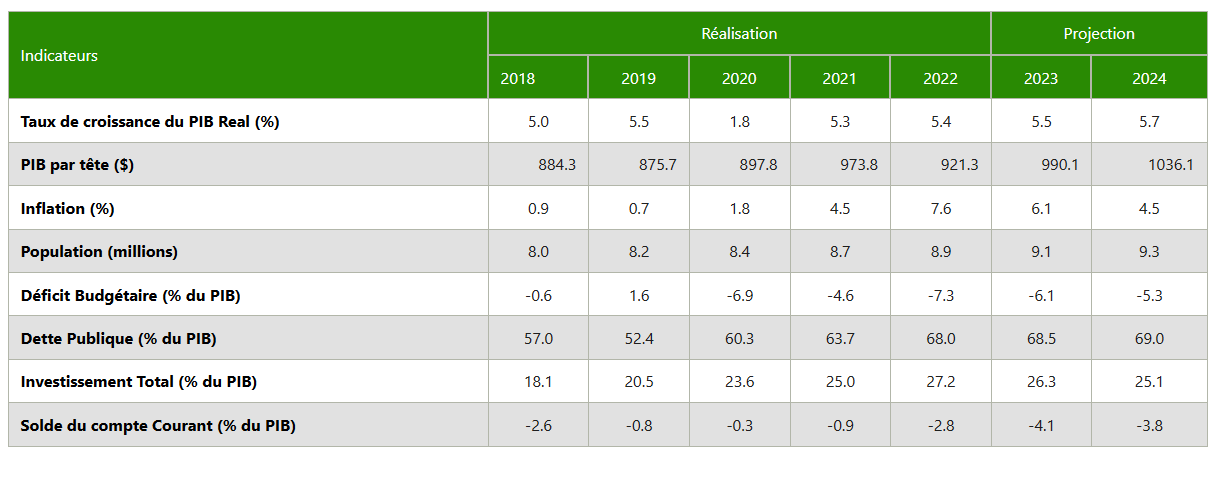
Macroeconomic Performance
Table 1: Overview of some macroeconomic indicators
 Togo recorded an average growth rate of 4.6 per cent over the last five years. The Togolese economy grew by 5.4 per cent in 2022, up from 5.3 per cent in 2021, despite the rising inflation. Average inflation reached a 2-decade high of 7.6 per cent, up from 4.5 per cent in 2021, on account of rising food, fertiliser and energy prices. The fiscal deficit increased markedly to 7.3 per cent of GDP, up from 4.6 per cent of GDP, owing to the government’s interventions in the downstream petroleum sector and other social expenditures to cushion the citizenry from the vagaries of the war in Ukraine. The widening fiscal deficit engendered a marked increase in the debt-to-GDP ratio, which reached 68.0 per cent of GDP, from 63.7 per cent of GDP in 2021. The current account balance also worsened to -2.8 per cent of GDP, from -0.9 per cent of GDP in 2021.
Togo recorded an average growth rate of 4.6 per cent over the last five years. The Togolese economy grew by 5.4 per cent in 2022, up from 5.3 per cent in 2021, despite the rising inflation. Average inflation reached a 2-decade high of 7.6 per cent, up from 4.5 per cent in 2021, on account of rising food, fertiliser and energy prices. The fiscal deficit increased markedly to 7.3 per cent of GDP, up from 4.6 per cent of GDP, owing to the government’s interventions in the downstream petroleum sector and other social expenditures to cushion the citizenry from the vagaries of the war in Ukraine. The widening fiscal deficit engendered a marked increase in the debt-to-GDP ratio, which reached 68.0 per cent of GDP, from 63.7 per cent of GDP in 2021. The current account balance also worsened to -2.8 per cent of GDP, from -0.9 per cent of GDP in 2021.
Outlook
The Togolese economy is projected to grow by 5.5 per cent in 2023 and further to 5.7 per cent in 2024 as average inflation eases to 6.1 per cent and 4.5 per cent in 2023 and 2024, respectively. The decline in inflation is expected to create some fiscal space for the government, particularly since its payouts to subsidise fuel and fertiliser costs will reduce significantly. In effect, the fiscal balance is projected to narrow to -6.1 per cent of GDP in 2023 and further to -5.3 per cent of GDP in 2024. This will slow the growth in public debt, with the debt-to-GDP ratio reaching 68.5 per cent in 2023 and 69.0 per cent in 2024. However, the current account balance is projected to worsen to -4.1 per cent of GDP in 2023, before improving to -3.8 per cent in 2024.
Probable Headwinds
Togo’s economy faces a myriad of downside risks, just like the rest of the countries in the sub-region. The insecurity in the Sahelian region resulted in sporadic attacks in some parts of Northern Togo in 2022. A recurrence in 2023 could adversely affect food production. Furthermore, the tight global financial conditions could adversely affect the country’s ability to mobilise enough resources for its developmental programmes in 2023 and 2024. High-interest costs could also derail the fiscal consolidation programme, with adverse implications for debt sustainability, given that the country is only a few percentage points away from the 70 per cent debt-to-GDP threshold.

